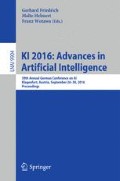Abstract
One long term goal of artificial intelligence and robotics research is the development of robot systems, which have approximately the same cognitive, communicational, and handling abilities like humans. This yields several challenges for future robot systems. For instance in the field of communicational abilities, future robot systems have to bridge between natural communication methods of the human, primarily utilizing symbols like words or gestures, and the natural communication methods of artificial systems, primarily utilizing low-level subsymbolic control interfaces. In this work, we outline a system which utilizes physical properties, respectively physical effects for the mapping between a high-level symbolic user interface and a low-level subsymbolic robot control interface.
Access this chapter
Tax calculation will be finalised at checkout
Purchases are for personal use only
References
De Schutter, J., De Laet, T., Rutgeerts, J., Decré, W., Smits, R., Aertbeliën, E., Claes, K., Bruyninckx, H.: Constraint-based task specification and estimation for sensor-based robot systems in the presence of geometric uncertainty. Int. J. Robot. Res. 26(5), 433–455 (2007)
Finkemeyer, B., Kroger, T., Wahl, F.M.: The adaptive selection matrix a key component for sensor-based control of robotic manipulators. In: IEEE International Conference on Robotics and Automation (ICRA), pp. 3855–3862. IEEE (2010)
Harnad, S.: The symbol grounding problem. Phys. D Nonlinear Phenom. 42(1), 335–346 (1990)
Coradeschi, S., Loutfi, A., Wrede, B.: A short review of symbol grounding in robotic and intelligent systems. KI-Künstliche Intelligenz 27(2), 129–136 (2013)
Vogt, P.: The physical symbol grounding problem. Cogn. Syst. Res. 3(3), 429–457 (2002)
Cangelosi, A.: Grounding language in action and perception: from cognitive agents to humanoid robots. Phys. life Rev. 7(2), 139–151 (2010)
Lauria, S., Bugmann, G., Kyriacou, T., Klein, E.: Mobile robot programming using natural language. Robot. Auton. Syst. 38(3), 171–181 (2002)
Kemke, C.: “From Saying to doing”- Natural Language Interaction with Artificial Agents and Robots. INTECH Open Access Publisher (2007)
Matuszek, C., Herbst, E., Zettlemoyer, L., Fox, D.: Learning to parse natural language commands to a robot control system. In: Desai, J.P., Dudek, G., Khatib, O., Kumar, V. (eds.) Experimental Robotics. STAR, vol. 88, pp. 403–415. Springer, Heidelberg (2013)
Kollar, T., Tellex, S., Roy, D., Roy, N.: Grounding verbs of motion in natural language commands to robots. In: Khatib, O., Kumar, V., Sukhatme, G. (eds.) Experimental Robotics. STAR, vol. 79, pp. 31–47. Springer, Heidelberg (2012)
Laengle, T., Lueth, T.C., Stopp, E., Herzog, G., Kamstrup, G.: Kantra-a natural language interface for intelligent robots. In: Intelligent Autonomous Systems (IAS 4), pp. 357–364 (1995)
Knoll, A., Hildenbrandt, B., Zhang, J.: Instructing cooperating assembly robots through situated dialogues in natural language. In: IEEE International Conference on Robotics and Automation, vol. 1, pp. 888–894. IEEE (1997)
Pires, N.: Robot-by-voice: experiments on commanding an industrial robot using the human voice. Ind. Robot Int. J. 32(6), 505–511 (2005)
Tenorth, M., Nyga, D., Beetz, M.: Understanding and executing instructions for everyday manipulation tasks from the world wide web. In: IEEE International Conference on Robotics and Automation (ICRA), pp. 1486–1491. IEEE (2010)
Stenmark, M., Nugues, P.: Natural language programming of industrial robots. In: 44th International Symposium on Robotics (ISR), pp. 1–5. IEEE (2013)
Misra, D.K., Sung, J., Lee, K., Saxena, A.: Tell me dave: context-sensitive grounding of natural language to manipulation instructions. In: Proceedings of Robotics: Science and Systems (RSS), Berkeley, USA (2014). doi:10.15607/RSS.2014.X.005
Spangenberg, M., Henrich, D.: Grounding of actions based on verbalized physical effects and manipulation primitives. In: IEEE/RSJ International Conference on Intelligent Robots and Systems (IROS), pp. 844–851. IEEE (2015)
Bonasso, R.P., Firby, R.J., Gat, E., Kortenkamp, D., Miller, D.P., Slack, M.G.: Experiences with an architecture for intelligent, reactive agents. J. Exp. Theor. Artif. Intell. 9(2–3), 237–256 (1997)
Spangenberg, M., Henrich, D.: Towards a domain specific language for sensor-based actions. Appl. Mech. Mater. 840, 42–49 (2016)
International Organization of Standardization: ISO Standards Handbook: Quantifies and Units (1993)
Awrejcewicz, J.: Classical Mechanics: Kinematics and Statics. Advances in Mechanics and Mathematics. Springer, New York (2012)
Spangenberg, M., Henrich, D.: Towards an intuitive interface for instructing robots handling tasks based on verbalized physical effects. In: RO-MAN: The 23rd IEEE International Symposium on Robot and Human Interactive Communication, pp. 79–84. IEEE (2014)
—: Symbol grounding for symbolic robot commands based on physical properties. In: IEEE International Conference on Information and Automation. IEEE (2016, accepted, to appear)
Thomas, U., Wahl, F.M.: Planning sensor feedback for assembly skills by using sensor state space graphs. In: Su, C.-Y., Rakheja, S., Liu, H. (eds.) ICIRA 2012, Part II. LNCS, vol. 7507, pp. 696–707. Springer, Heidelberg (2012)
Author information
Authors and Affiliations
Corresponding author
Editor information
Editors and Affiliations
Rights and permissions
Copyright information
© 2016 Springer International Publishing AG
About this paper
Cite this paper
Spangenberg, M., Henrich, D. (2016). Symbolic Robot Commanding Utilizing Physical Properties - System Overview. In: Friedrich, G., Helmert, M., Wotawa, F. (eds) KI 2016: Advances in Artificial Intelligence. KI 2016. Lecture Notes in Computer Science(), vol 9904. Springer, Cham. https://doi.org/10.1007/978-3-319-46073-4_19
Download citation
DOI: https://doi.org/10.1007/978-3-319-46073-4_19
Published:
Publisher Name: Springer, Cham
Print ISBN: 978-3-319-46072-7
Online ISBN: 978-3-319-46073-4
eBook Packages: Computer ScienceComputer Science (R0)

